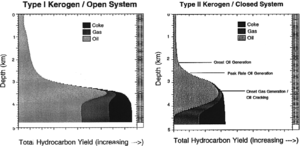Difference between revisions of "Open- vs closed-system generation modeling"
Cwhitehurst (talk | contribs) |
Cwhitehurst (talk | contribs) m (added Category:Treatise Handbook 3 using HotCat) |
||
| (2 intermediate revisions by 2 users not shown) | |||
| Line 14: | Line 14: | ||
| isbn = 0-89181-602-X | | isbn = 0-89181-602-X | ||
}} | }} | ||
| − | [[Petroleum generation|Hydrocarbon generation]] results from computerized 1-D basin [[modeling]] software are typically presented as either open- or closed-system yields. '''Open-system''' models are based on the assumption that hydrocarbons have been expelled from the source rock, have been transported away, and are no longer subject to the thermal conditions of the 1-D model. '''Closed-system''' models assume the hydrocarbons have not been expelled from the source rock and that all generated hydrocarbon phases are subject to further cracking to lighter phases. | + | [[Petroleum generation|Hydrocarbon generation]] results from computerized 1-D basin [[modeling]] software are typically presented as either open- or closed-system yields. '''Open-system''' models are based on the assumption that hydrocarbons have been expelled from the source rock, have been transported away, and are no longer subject to the thermal conditions of the 1-D model. '''Closed-system''' models assume the hydrocarbons have not been expelled from the source rock and that all generated hydrocarbon phases are subject to further [[cracking]] to lighter phases. |
==Implications for yield predictions== | ==Implications for yield predictions== | ||
| Line 20: | Line 20: | ||
[[file:evaluating-source-rocks_fig6-19.png|300px|thumb|{{figure number|1}}Examples of yield curves for the same well, based on both open- and closed-system modeling conditions. Copyright: results of Genex 1-D basin modeling software, courtesy Institute Français du Petrole.]] | [[file:evaluating-source-rocks_fig6-19.png|300px|thumb|{{figure number|1}}Examples of yield curves for the same well, based on both open- and closed-system modeling conditions. Copyright: results of Genex 1-D basin modeling software, courtesy Institute Français du Petrole.]] | ||
| − | [[:file:evaluating-source-rocks_fig6-19.png|Figure 1]] shows examples of yield curves for the same well, based on both open- and closed-system modeling conditions. The open-system model is run with an expulsion efficiency of 70%, meaning 70% of the generated hydrocarbons were expelled before subsequent maturation and were not subjected to secondary cracking to lighter phases. The closed-system model does not incorporate an expulsion component; therefore, the hydrocarbons are subject to cracking to lighter phases. The closed-system model (right) predicts significantly greater quantities of gas at depth than the open-system model (left). | + | [[:file:evaluating-source-rocks_fig6-19.png|Figure 1]] shows examples of yield curves for the same well, based on both open- and closed-system modeling conditions. The open-system model is run with an expulsion efficiency of 70%, meaning 70% of the generated hydrocarbons were expelled before subsequent [[maturation]] and were not subjected to secondary cracking to lighter phases. The closed-system model does not incorporate an expulsion component; therefore, the hydrocarbons are subject to cracking to lighter phases. The closed-system model (right) predicts significantly greater quantities of gas at depth than the open-system model (left). |
'''Note:''' In general, open-system models overestimate the quantities of liquids present in a system. Closed-system models overestimate the amount of gas present in the system and are pessimistic in terms of predicting quantities of liquids. Closed-system models typically are not run any more. However, when evaluating older models, consider this effect. | '''Note:''' In general, open-system models overestimate the quantities of liquids present in a system. Closed-system models overestimate the amount of gas present in the system and are pessimistic in terms of predicting quantities of liquids. Closed-system models typically are not run any more. However, when evaluating older models, consider this effect. | ||
| Line 38: | Line 38: | ||
[[Category:Critical elements of the petroleum system]] | [[Category:Critical elements of the petroleum system]] | ||
[[Category:Evaluating source rocks]] | [[Category:Evaluating source rocks]] | ||
| + | [[Category:Treatise Handbook 3]] | ||
Latest revision as of 15:15, 14 February 2022
| Exploring for Oil and Gas Traps | |

| |
| Series | Treatise in Petroleum Geology |
|---|---|
| Part | Critical elements of the petroleum system |
| Chapter | Evaluating source rocks |
| Author | Carol A. Law |
| Link | Web page |
| Store | AAPG Store |
Hydrocarbon generation results from computerized 1-D basin modeling software are typically presented as either open- or closed-system yields. Open-system models are based on the assumption that hydrocarbons have been expelled from the source rock, have been transported away, and are no longer subject to the thermal conditions of the 1-D model. Closed-system models assume the hydrocarbons have not been expelled from the source rock and that all generated hydrocarbon phases are subject to further cracking to lighter phases.
Implications for yield predictions
Figure 1 shows examples of yield curves for the same well, based on both open- and closed-system modeling conditions. The open-system model is run with an expulsion efficiency of 70%, meaning 70% of the generated hydrocarbons were expelled before subsequent maturation and were not subjected to secondary cracking to lighter phases. The closed-system model does not incorporate an expulsion component; therefore, the hydrocarbons are subject to cracking to lighter phases. The closed-system model (right) predicts significantly greater quantities of gas at depth than the open-system model (left).
Note: In general, open-system models overestimate the quantities of liquids present in a system. Closed-system models overestimate the amount of gas present in the system and are pessimistic in terms of predicting quantities of liquids. Closed-system models typically are not run any more. However, when evaluating older models, consider this effect.
See also
- Relationships between maturity and hydrocarbon generation
- Kerogen type and hydrocarbon generation
- Kerogen type and maturity
- Kerogen type and transformation ratio
- Kerogen types: comparison of maturity measures
